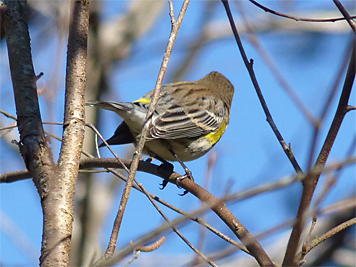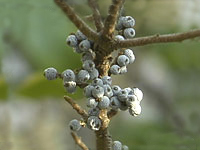In winter, one of the most frequently encountered birds on the Trail around the Outdoor Exhibits at the Museum is a rather small, indistinct bird. Before telling you what it is, I thought it might be fun to take a little photo quiz.
But first, some hints. This bird is only found in our area in winter (usually October through April). It is largely insectivorous but can switch over to fruit in the winter, especially the fruit of the Wax Myrtle. It will also eat poison ivy, greenbrier, juniper and other small fruits. The ability to switch over to seeds and fruit allows the bird to stay farther north in winter than many of the other members of its family. If this little gray-brown bird (it’s much brighter in color during the breeding season) visits your bird feeder it will most likely come to suet.
If you’ve been able to guess what the bird is from the very helpful hints above, great, if not here’s a photo:

If you were able to identify the bird from the above image (and many useful hints), give yourself a pat on the back. However, if you’re still not sure…

Still don’t know what the little bird with the yellow on its rump is?

Well done, you’ve got it!
Although you may see Pine Warblers (year-round), and possibly a Black & White, Cape May, or Orange-crowned Warbler in winter at the Museum, one of the most often seen birds, and certainly the most often observed warbler at this time of year, is the Yellow-rumped Warbler. Simply stand in the proximity of one of the many plantings of Wax Myrtle (Morella cerifera) in Catch the Wind, Explore the Wild, or the Dinosaur Trail and you will see a Butter-butt (Yellow-rumped Warbler).

By the way, Yellow-rumped Warblers have two forms, “Audubon’s” Yellow-rumped Warbler in the west and “Myrtle” Yellow-rumped Warbler in the east. At one time they were considered separate species but are now lumped together as one. The eastern form was once known as the Myrtle Warbler after its fondness for Wax Myrtle.